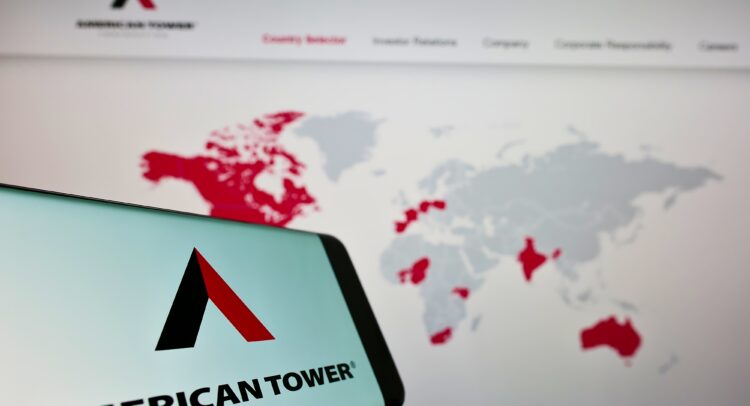American Tower (NYSE:AMT), a cell tower REIT, is enjoying long-term structural growth trends. More and more devices are connected to the internet, boosting demand for its communication assets. However, largely due to higher interest rates, the company’s bottom line will take a hit in 2023 before returning to growth in 2024. While there is no immediate catalyst for the shares — the company is focused on debt reduction, and interest expenses are rising as debt is refinanced at higher rates — the long-term investment story is intact. Still, I am neutral on the stock.

Operational Overview
Despite its name, American Tower is a REIT with heavy international exposure. The company operates communications real estate in five main markets, namely the U.S. & Canada at 47% of 2022 consolidated revenues, Latin America at 16%, Africa at 11%, Asia-Pacific at 10%, and Europe at 7% of 2022 revenues, with the remaining 7% attributed to Data Centers in the U.S.
American Tower delivered adjusted funds from operations (known as AFFO, a cash-flow metric used by REITs to represent underlying business performance) of $2.34/share in Q4, up 11.4% year-over-year. For the full year, AFFO was $9.76/share, up 3.5% compared to 2021.
Further, the company ended 2022 with a net debt position of $36.6 billion. 78% of American Tower’s debt is fixed-rate debt. However, some 11.6% of total debt matures this year and will present a headwind as it is rolled over. Case in point, recent debt issuance has been at yields of around 5.5%-5.65%, while expiring debt was issued at a yield of 3.26%-4.71%.
Monetary Policy Outlook, Interest Rate Headwinds
The Federal Reserve’s monetary policy affects American Tower in two ways. First, demand for real estate generally weakens as monetary policy is tightened. This is because fixed-income investors have more options to generate current income when rates are high. Furthermore, real estate is often financed with debt, which becomes more expensive. This brings us to the second way that American Tower is affected by interest rate hikes.
At the end of 2022, some 22% of the company’s debt was floating-rate debt. Hence, every time interest rates go up, American Tower automatically has to pay more on 22% of its debt. At its March 22 monetary policy meeting, the Federal Reserve signaled further tightening to come. What’s more, chairman Jerome Powell did not see the case for interest rate cuts in the second half of 2023, putting the Federal Reserve at odds with market expectations.
A prolonged period of interest rates hovering around 5% will keep pressure on REITs and American Tower through the two channels outlined above. That said, the bulk of the monetary tightening is clearly behind us, and the big interest rate hit to earnings should be limited to 2023.
AMT’s Outlook for 2023
Given its strong finish to 2022, AMT’s guidance for 2023 is somewhat underwhelming, with AFFO per share projected in a range of $9.49-$9.72/share, down 1.6% from 2022.
The decrease is largely due to higher financing costs (72.1% of total negative impact), foreign exchange headwinds (10.8% impact), and India-related problems (17.2% impact). India represents just 3.2% of total 2022 revenues, but American Tower has recently been having problems collecting rent payments in full. The company is considering its options in the country.
Absent these three negative effects, AFFO would have increased by 9%. After growing by 14.5% in 2022 on the back of M&A, total revenue is set to increase by 2.9% in 2023.
Of the approximately $4.7 billion in capital spending in 2023, 63.8% will go toward the common stock dividend, 31.9% to discretionary CapEx to grow the business, and 4.3% will go toward non-discretionary/maintenance CapEx.
American Tower’s Implied Capitalization Rate and Why It Matters
It’s always important to consider the capitalization rate (the rate of return on a real estate investment property based on its expected cash flows) of a REIT you invest in and not just the yield based on AFFO. Usually, to increase returns, REITs borrow from banks and other lenders. This often results in a high AFFO yield.
However, if the REIT needs to sell a property on the market, the buyer will consider the capitalization rate as it encompasses all cash flows of the property to equity and debt holders combined. To arrive at a capitalization rate, I will use the AFFO and interest expense forecast for 2023 and divide the sum by the company’s enterprise value.
In 2023, AFFO should be about $4.5 billion and interest expense about $1.4 billion. Against an enterprise value of about $127 billion, the market-implied capitalization rate for AMT is 4.6%.
Considering that the company has rent escalators in place for the U.S. market at an average of 3% per year — or enjoys an inflation-based indexation for its international exposure — investors are looking at a nominal return of about 7.6% annually.
For comparison, this represents a roughly 4% risk premium compared to the 3.5% nominal return offered on U.S. 10-year Treasury notes. Looking at its largest peer, Prologis (NYSE:PLD), which I covered here, American Tower offers a higher immediate capitalization rate (4.6% vs. 4% at Prologis currently) but does not hold the same long-term rent increase potential.
Is AMT Stock a Buy, According to Analysts?
Turning to Wall Street, American Tower earns a Strong Buy consensus rating based on 12 Buys, two Holds, and zero Sell ratings. Additionally, American Tower stock’s average price target is $242.92, implying 26.2% upside.

The Takeaway
American Tower continues to benefit from long-term tailwinds. However, interest rate headwinds will obscure top-line growth and result in negative AFFO growth this year. Nonetheless, given that the bitter pill of higher interest rates has already run its course, AFFO per share should return to a mid-single-digit growth rate in 2024, driven by underlying market fundamentals and discretionary high-yielding CapEx to expand the company into new markets.
















